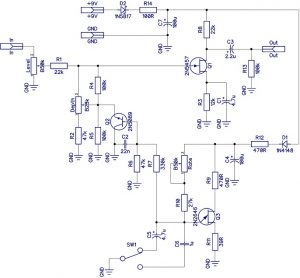
Flying at 300 BPM
For a long time I didn’t know why one of the tremolos in Earthquaker Devices lineup is called Hummingbird. When I started this blog entry I was looking for an appropriate title and then I suddenly realized, that the reason might be that the effect at the fastest Rate setting sounds a bit like a hummingbird’s wing. Or like a chopper. Or like a chainsaw. This is a quite extreme tremolo effect. By turning the Depth pot down we still get a very pronounced tremolo. It is very choppy, mostly like a square-wave tremolo. The Rate pot can go from quite slow to very-very fast in two ranges with the flip of a switch. In the fastest setting it can almost sound like a fuzz. The third pot is the Level pot. On tremolos or on modulation effects in general this is not a common feature, but very useful. The human ear tends to hear the modulated sounds (especially the amplitude modulated sounds, such as the tremolo) more quiet as the dry signal, even if the level is the same. This can be compensated with the Level pot really good.
 The circuit is not too complicated, it is based on the Vox Repeat Percussion. The low frequency oscillator is realized here with an UJT (Uni-Junction Transistor, Q3). Q3 acts here like a voltage controlled trap door: the C5 or C6 cap (whichever is used in the circuit by the Sw1 switch) charges until it reaches the voltage where Q3’s emitter-base1 channel opens and dumps the cap’s charge to ground over the R11 resistor. At this point the cap is discharged, Q3 closes and the cycle starts again. The speed of the cycle is controlled by the R10 resistor and the Rate pot, as the C5/C6 caps are charged over these. Q2 is controlled with this oscillator: when it is open, it dumps the signal to ground, while it is closed it does nothing. Q1 is just a final amplification stage. The sudden changes in sound (“choppyness”) comes from two factors: on one hand the oscillator has very quick changes because of the quick opening and closing of Q3. On the other hand also Q2 changes its “open” and “closed” state very quickly. The Depth pot controls how much of the signal goes to the direction of Q2. Since some of the signal always goes this direction, even in the lowest Depth setting the effect is quite pronounced. The Level pot controls the signal level at the input. Following mods can be considered:
The circuit is not too complicated, it is based on the Vox Repeat Percussion. The low frequency oscillator is realized here with an UJT (Uni-Junction Transistor, Q3). Q3 acts here like a voltage controlled trap door: the C5 or C6 cap (whichever is used in the circuit by the Sw1 switch) charges until it reaches the voltage where Q3’s emitter-base1 channel opens and dumps the cap’s charge to ground over the R11 resistor. At this point the cap is discharged, Q3 closes and the cycle starts again. The speed of the cycle is controlled by the R10 resistor and the Rate pot, as the C5/C6 caps are charged over these. Q2 is controlled with this oscillator: when it is open, it dumps the signal to ground, while it is closed it does nothing. Q1 is just a final amplification stage. The sudden changes in sound (“choppyness”) comes from two factors: on one hand the oscillator has very quick changes because of the quick opening and closing of Q3. On the other hand also Q2 changes its “open” and “closed” state very quickly. The Depth pot controls how much of the signal goes to the direction of Q2. Since some of the signal always goes this direction, even in the lowest Depth setting the effect is quite pronounced. The Level pot controls the signal level at the input. Following mods can be considered:
– The caps C5/C6 control the rate ranges that the two switch positions can provide. The larger the cap the longer it takes to charge it, so longer rate-times can be achived by using larger caps here.
– The Q1 output stage uses a FET transistor. These days FETs are not very common anymore, most of them are out of production and hard to obtain. Even if you can get some, they tend to be quite expensive too. You can try here other FET types as well (like 2N5485, J201, J202, etc. – mind the pinout though), but then you might need to adjust the R8 resistor. I would suggest to temporarily use a pot with a 1-2k resistor in series here until you find the necessary value and then replace it with a fixed resistor.
– Q2 can be more or less freely chosen from the wide variety of BJT transistors. 2N5088, 2N3904, MPSA18 are very common ones that can be used, but you can try virtually anything, only mind the pinout here too.
If you want a very distinct and unique tremolo I can recommend this one for you. The build docu can be found under the Projects menu.


No Comments